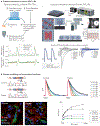Cardiac optogenetics: a decade of enlightenment
- PMID: 33340010
- PMCID: PMC8127952
- DOI: 10.1038/s41569-020-00478-0
Cardiac optogenetics: a decade of enlightenment
Abstract
The electromechanical function of the heart involves complex, coordinated activity over time and space. Life-threatening cardiac arrhythmias arise from asynchrony in these space-time events; therefore, therapies for prevention and treatment require fundamental understanding and the ability to visualize, perturb and control cardiac activity. Optogenetics combines optical and molecular biology (genetic) approaches for light-enabled sensing and actuation of electrical activity with unprecedented spatiotemporal resolution and parallelism. The year 2020 marks a decade of developments in cardiac optogenetics since this technology was adopted from neuroscience and applied to the heart. In this Review, we appraise a decade of advances that define near-term (immediate) translation based on all-optical electrophysiology, including high-throughput screening, cardiotoxicity testing and personalized medicine assays, and long-term (aspirational) prospects for clinical translation of cardiac optogenetics, including new optical therapies for rhythm control. The main translational opportunities and challenges for optogenetics to be fully embraced in cardiology are also discussed.
Figures







Similar articles
-
Cardiac optogenetics: a novel approach to cardiovascular disease therapy.Europace. 2018 Nov 1;20(11):1741-1749. doi: 10.1093/europace/eux345. Europace. 2018. PMID: 29253159 Review.
-
Cardiac applications of optogenetics.Prog Biophys Mol Biol. 2014 Aug;115(2-3):294-304. doi: 10.1016/j.pbiomolbio.2014.07.001. Epub 2014 Jul 15. Prog Biophys Mol Biol. 2014. PMID: 25035999 Free PMC article. Review.
-
Optical mapping and optogenetics in cardiac electrophysiology research and therapy: a state-of-the-art review.Europace. 2024 Feb 1;26(2):euae017. doi: 10.1093/europace/euae017. Europace. 2024. PMID: 38227822 Free PMC article. Review.
-
Shining light on cardiac electrophysiology: From detection to intervention, from basic research to translational applications.Life Sci. 2021 Jun 1;274:119357. doi: 10.1016/j.lfs.2021.119357. Epub 2021 Mar 15. Life Sci. 2021. PMID: 33737082 Review.
-
Cardiac optogenetics.Am J Physiol Heart Circ Physiol. 2013 May;304(9):H1179-91. doi: 10.1152/ajpheart.00432.2012. Epub 2013 Mar 1. Am J Physiol Heart Circ Physiol. 2013. PMID: 23457014 Free PMC article. Review.
Cited by
-
Developing Drosophila melanogaster Models for Imaging and Optogenetic Control of Cardiac Function.J Vis Exp. 2022 Aug 25;(186):10.3791/63939. doi: 10.3791/63939. J Vis Exp. 2022. PMID: 36094265 Free PMC article.
-
Optogenetics meets physiology.Pflugers Arch. 2023 Dec;475(12):1369-1373. doi: 10.1007/s00424-023-02887-9. Epub 2023 Dec 4. Pflugers Arch. 2023. PMID: 38047968 Free PMC article. No abstract available.
-
Molecular and cellular neurocardiology in heart disease.J Physiol. 2025 Mar;603(7):1689-1728. doi: 10.1113/JP284739. Epub 2024 May 22. J Physiol. 2025. PMID: 38778747 Review.
-
OptoDyCE-plate as an affordable high throughput imager for all optical cardiac electrophysiology.bioRxiv [Preprint]. 2023 Aug 31:2023.08.29.555447. doi: 10.1101/2023.08.29.555447. bioRxiv. 2023. Update in: J Mol Cell Cardiol Plus. 2023 Dec;6:100054. doi: 10.1016/j.jmccpl.2023.100054. PMID: 37693544 Free PMC article. Updated. Preprint.
-
Optogenetic Activation of Intrinsic Cardiac Autonomic Neurons in Excised Perfused Mouse Hearts.J Vis Exp. 2025 Mar 28;(217):10.3791/67364. doi: 10.3791/67364. J Vis Exp. 2025. PMID: 40228035 Free PMC article.
References
-
- Arrenberg AB, Stainier DY, Baier H & Huisken J Optogenetic control of cardiac function. Science 330, 971–974 (2010). - PubMed
-
- Bruegmann T et al. Optogenetic control of heart muscle in vitro and in vivo. Nat. Methods 7, 897–900 (2010). - PubMed
-
- Hofmann B et al. Light induced stimulation and delay of cardiac activity. Lab Chip 10, 2588–2596 (2010). - PubMed
-
- Salama G & Morad M Merocyanine 540 as an optical probe of transmembrane electrical activity in the heart. Science 48, 485–487 (1976). - PubMed
Publication types
MeSH terms
Substances
Grants and funding
LinkOut - more resources
Full Text Sources
Other Literature Sources
Medical

